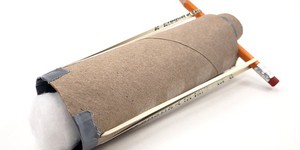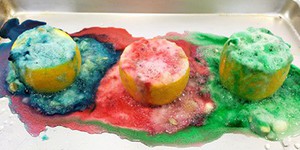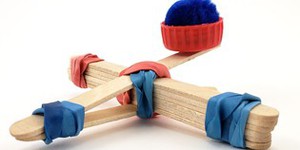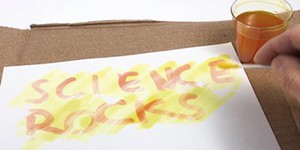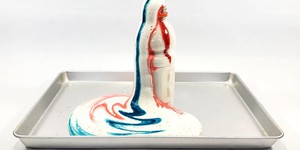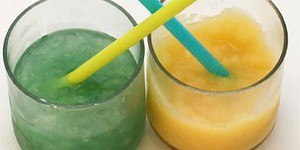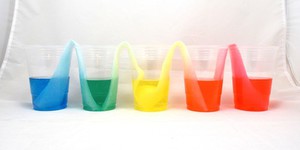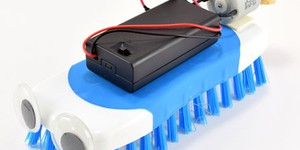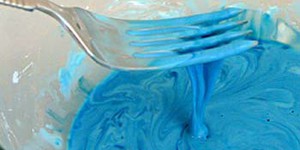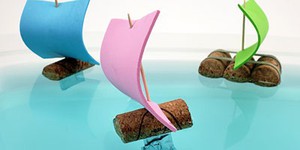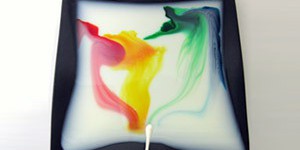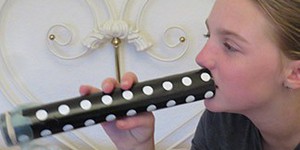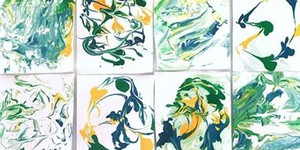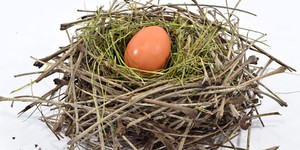Fun Science Experiments for Young Kids
Young kids are natural scientists and engineers. They are constantly asking why and exploring the world around them. Which is why they are the perfect age to enjoy these kid-friendly science experiments! Each experiment is fast to set up, uses household materials, and provides lots of fun, discovery, and learning.
Browse our library of science experiments for more fun ideas.
Have you ever stretched and launched a rubber band at someone? Put that energy to good use and build a rubber band-powered cotton ball launcher in this fun activity!
Make a colorful erupting volcano in your kitchen with lemons and baking soda!
Catapults were mighty handy for pirates in the golden age of piracy (during the 17th century). And medieval knights used them centuries earlier for taking down massive castle walls. Even Greeks and Romans used catapults about 2,000 years ago! These simple machines are quite handy, as long as you know how to aim them! In this science activity you will try your hand at catapult technology. Can you predict where your cotton ball will land?
Have you ever wanted to send your friend a secret message that no-one else can read? Then you might know of invisible ink—a special type of ink that you can use for writing and that does not show up on paper. Only after a special treatment will it appear again magically, and the message can be read. How does this work? Find out in this activity and write your own secret messages!
Create a giant foaming reaction and wow your friends with this classic science demonstration! With just a few simple ingredients, you can make something that looks like toothpaste being squeezed from a tube—but so big, it must be for elephants!
It's gooey. It's sticky. It's slime! Learn to make your own homemade slime with this quick and easy recipe.
Do you enjoy ice-cold drinks? A slushy is about as close as you can get to liquid ice: colder than water, but more drinkable than ice! Using some common household items, a little bit of patience, and the help of science, you can make this delicious, sweet drink at home. Try the activity, and you will be rewarded with a delightful treat!
Imagine this challenge: You have two glasses of water—one empty and one full. You want to pour half of the full glass into the empty one. The twist? You aren't allowed to pick up either glass! Can you get the water to "walk" between the glasses using nothing but a paper towel? Try this activity to find out!
Brushbots are a simple, fun type of robot that you can build out of arts and crafts materials. They are easy to build and you do not need any previous experience with robotics. You can build them yourself, build two robots with a friend and race them against each other, or even make them sumo wrestle! Go to the Materials section to see what parts you need to build a brushbot, and see the instructions for a step-by-step guide on how to build one.
Have you ever wondered what whipped cream, jelly, and milk have in common? Aside from all being tasty, they are also all made up of tiny particles that are dispersed, or distributed, in water. This type of mixture is called a heterogeneous mixture. Some of these have very interesting physical properties, such as acting like a solid and a liquid at the same time! In this activity, you will get to create Oobleck, a mixture that is made using cornstarch and water, and then explore these…
It's time to set sail! Even if you live nowhere near a lake or ocean, you will get to do some sailing in this science activity as you build your own toy sailboat. But first, you have to make sure your boat doesn't capsize! Are you up for the challenge?
Have you ever seen a rainbow after a rainfall, or drawn a rainbow for fun? They can be fun to make using colorful markers or other craft supplies. But did you know you can actually make a simple rainbow using milk, liquid detergent (i.e., soap), and food coloring? How the rainbow is created by this mixture might surprise you! In this science activity, you will make your own milk rainbow and explore how detergent and surface tension are involved in its creation.
Do you remember your last parade, party, or fair? You might have been surrounded by sounds of all kinds: fireworks, music, and, maybe even the famous (or infamous) sound of kazoos. A kazoo is a very simple musical instrument, made up of a hollow pipe with a hole in it. They may be simple, but these little noisemakers are a great way to explore sound. In this activity you'll be investigating how kazoos work by building your own!
Do you like both, arts and science? Then this is the perfect activity for you! You will create beautiful marbled paper cards and practice science at the same time! The only materials you need are shaving cream, food coloring, and sheets of paper. It might get a bit messy, but that is part of the fun!
Different types of birds lay their eggs in different places. Some build tiny nests in bushes, some build enormous nests in tall trees. Some lay their eggs directly on the ground or on rocky ledges. Those that build nests use many different types of materials. In this project you will try to build your own bird nest using only natural materials that you can find outside. Can you do better than a bird?


